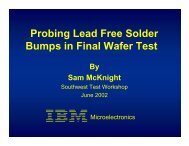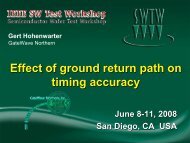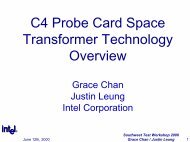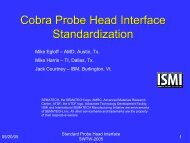Podium Presentation Template - Semiconductor Wafer Test Workshop
Podium Presentation Template - Semiconductor Wafer Test Workshop
Podium Presentation Template - Semiconductor Wafer Test Workshop
Create successful ePaper yourself
Turn your PDF publications into a flip-book with our unique Google optimized e-Paper software.
Robert Doherty<br />
Analog Devices, Inc.<br />
Robert Rogers<br />
Wentworth Laboratories, Inc.<br />
Vertical Probe Alternative for<br />
Cantilever Pad Probing<br />
June 8-11, 8<br />
2008<br />
San Diego, CA USA
Introduction<br />
This presentation summarizes Analog Devices, Inc.’s<br />
evaluation and testing results using an alternative vertical<br />
probe card with pointed probes for testing ADI’ s mixed<br />
signal, multi dut applications on bond pads.<br />
This evaluation is intended to investigate vertical probe<br />
card technology as an alternative to traditional cantilever<br />
cards used by ADI. The potential benefits of smaller scrub<br />
marks, higher frequency, longer card life, easy in house<br />
maintenance and potential over-all value when compared<br />
to either cantilever or higher cost membrane cards which<br />
ADI’s uses for higher frequency applications.<br />
June 8 to 11, 2008<br />
IEEE SW <strong>Test</strong> <strong>Workshop</strong> 2
Overview<br />
• Analog Devices Inc. testing needs<br />
• Project Objective<br />
• Benefits<br />
• <strong>Test</strong>ing Plan<br />
• Results<br />
• Probe design making this possible<br />
• Next Steps<br />
June 8 to 11, 2008<br />
IEEE SW <strong>Test</strong> <strong>Workshop</strong><br />
3
Analog Devices, Inc.<br />
<strong>Test</strong> Needs<br />
• High performance linear & mixed signal testing<br />
• Lowest cost per touchdown for vertical design<br />
• Low inductance paths for high frequency signals<br />
• Higher frequency than cantilever can provide<br />
• Provide the technical and production test<br />
benefits of vertical at a cost closer to cantilever<br />
• Minimize scrub marks for automotive products<br />
June 8 to 11, 2008<br />
IEEE SW <strong>Test</strong> <strong>Workshop</strong> 4
Project Objective<br />
• Develop a lower cost vertical probe card<br />
capability for lower volume but high performance<br />
analog components.<br />
• Develop this vertical probe capability to work on<br />
standard bond pad spacing and later for<br />
redistributed bump die<br />
• Maintain a price structure which is a cost<br />
effective alternative to membrane probe<br />
June 8 to 11, 2008<br />
IEEE SW <strong>Test</strong> <strong>Workshop</strong> 5
Design Objective<br />
Gussets<br />
Head Plate<br />
<strong>Test</strong> Head Direct Dock<br />
0.120 inches<br />
Fewer interconnects, decrease<br />
the signal path length across a<br />
probe card PCB to actual probe<br />
needle connection.<br />
3.03<br />
mm<br />
Probe<br />
Application<br />
HW<br />
June 8 to 11, 2008<br />
IEEE SW <strong>Test</strong> <strong>Workshop</strong> 6
Vertical Probe Benefits<br />
• Longer touchdown life between rebuilds<br />
• Higher test frequency capability<br />
• Ability to repair in-house<br />
• Reduced scrub mark size with pointed probe, vs.<br />
cantilever scrub<br />
• Use on low volume bump applications<br />
– Cost effective for ADI products<br />
June 8 to 11, 2008<br />
IEEE SW <strong>Test</strong> <strong>Workshop</strong> 7
Initial <strong>Test</strong> Plan<br />
• First design compared CRES on custom<br />
test chip designed for bump wafers<br />
– CRES Values compared to Cantilever<br />
• Data was only used to validate the probe<br />
card design concept, early work had stuck<br />
pins but did function electrically as<br />
desired.<br />
June 8 to 11, 2008<br />
IEEE SW <strong>Test</strong> <strong>Workshop</strong> 8
<strong>Test</strong> Plan<br />
• <strong>Test</strong> a Power Management chip using both a<br />
cantilever ring and new vertical probe card with<br />
the same wafers and compare the probe yield<br />
and needle performance.<br />
• Optimize the cleaning frequency as required<br />
– Started at once per wafer<br />
– later 3-4 times per wafer<br />
– settled for every 3,000 touchdowns<br />
• Forced Multi touchdown per DUT to accelerate wear & tear<br />
• Evaluate any degradation to the PCB and yields<br />
June 8 to 11, 2008<br />
IEEE SW <strong>Test</strong> <strong>Workshop</strong> 9
Value of Vertical Direct Docking<br />
There are several blocks within this interface that<br />
can cause a high Z condition.<br />
At each interface there can be a reflection which<br />
causes a distortion in DUT input signal. As a result,<br />
it can be inadequate for higher speed testing.<br />
Less reflection with simple Impedance<br />
SBI PCB<br />
Reflection<br />
ρ1<br />
Pogo ring Ring PCB Needle<br />
Reflection<br />
ρ2<br />
Reflection<br />
ρ3<br />
Reflection<br />
ρ4<br />
R0<br />
PCB~<br />
Membrane<br />
Total reflection<br />
ρ = 1<br />
L<br />
R0 L1 L2<br />
L3<br />
L4<br />
<strong>Test</strong>er<br />
Driver<br />
C1<br />
C2<br />
C3<br />
C4<br />
<strong>Test</strong>er<br />
Driver<br />
C<br />
June 8 to 11, 2008<br />
IEEE SW <strong>Test</strong> <strong>Workshop</strong> 10
Comparison of Substrate vs<br />
Direct Dock Interface<br />
Example: via Substrate Interface<br />
June 8 to 11, 2008<br />
IEEE SW <strong>Test</strong> <strong>Workshop</strong> 11
Comparison of Substrate vs<br />
Direct Dock Interface<br />
Example : Substrate Interface<br />
June 8 to 11, 2008<br />
IEEE SW <strong>Test</strong> <strong>Workshop</strong> 12
Comparison of Substrate vs<br />
Direct Dock Interface<br />
Example : Direct Dock<br />
June 8 to 11, 2008<br />
IEEE SW <strong>Test</strong> <strong>Workshop</strong> 13
Direct Dock PCB<br />
Gap between contacts= 66.6um<br />
June 8 to 11, 2008<br />
IEEE SW <strong>Test</strong> <strong>Workshop</strong> 14
Direct Dock PCB Design<br />
• Eliminates need for<br />
substrate (MLO, MLC)<br />
– Lower cost<br />
– No lead time for<br />
substrate fab<br />
– Analog in-house PCB<br />
design<br />
June 8 to 11, 2008<br />
IEEE SW <strong>Test</strong> <strong>Workshop</strong> 15
Analog Devices Probe Card<br />
June 8 to 11, 2008<br />
IEEE SW <strong>Test</strong> <strong>Workshop</strong> 16
Vertical Direct Dock Probe Card<br />
• Uses chemically etched pointed<br />
contacts to break through oxides<br />
• Effective alternative to cantilever type<br />
probe cards:<br />
– Does not require planarization or alignment<br />
maintenance<br />
– Easier, faster onsite maintainability<br />
– Large arrays<br />
– <strong>Test</strong> more devices simultaneously<br />
– Multi-die applications: 1x4, 1x8, 2x2, 2x4<br />
– Lower cost alternative to low volume high<br />
performance<br />
June 8 to 11, 2008<br />
IEEE SW <strong>Test</strong> <strong>Workshop</strong> 17
Cross Section of a Vertical<br />
Pointed Probe Head Design<br />
Upper Die<br />
Saber ® Probe<br />
Polymax Lower Die<br />
June 8 to 11, 2008<br />
IEEE SW <strong>Test</strong> <strong>Workshop</strong> 18
BeCu Pointed<br />
Saber ® Probe Properties<br />
Beryllium<br />
1.9%<br />
BeCu<br />
Copper<br />
98%<br />
Pointed Probe<br />
Chemically<br />
etched, no<br />
inherent stress<br />
Huge cross section<br />
•Current Capacity at 25 0 C :<br />
•Current Required to “Blow” :<br />
•Resistivity:<br />
•Conductivity @ 20 0 C :<br />
600 mA for 2 minutes<br />
1,300 mA<br />
7.0 uohm–cm<br />
.129 1Mohm–cm<br />
June 8 to 11, 2008<br />
IEEE SW <strong>Test</strong> <strong>Workshop</strong> 19
Direct Dock Vertical Probe<br />
Maintenance Process<br />
Insert contact thru upper die, lower die and push past<br />
detent<br />
Removal: Grasp contact and pull contact out<br />
June 8 to 11, 2008<br />
IEEE SW <strong>Test</strong> <strong>Workshop</strong> 20
Reduced Probe Marks<br />
• Pointed probe design for lower CRES<br />
• Pad sizes shrinking, thus smaller scrub<br />
marks are desirable<br />
• Probe and re-probe on same pads are<br />
now possible with minimal damage<br />
June 8 to 11, 2008<br />
IEEE SW <strong>Test</strong> <strong>Workshop</strong> 21
Results<br />
June 8 to 11, 2008<br />
IEEE SW <strong>Test</strong> <strong>Workshop</strong> 22
Results<br />
June 8 to 11, 2008<br />
IEEE SW <strong>Test</strong> <strong>Workshop</strong> 23
Various Probe marks<br />
Blade<br />
Vertical probe – 8 times<br />
Epoxy cantilever<br />
June 8 to 11, 2008<br />
IEEE SW <strong>Test</strong> <strong>Workshop</strong> 24
Results:<br />
Scrub Mark Comparison<br />
Vertical card gram force<br />
applied at 125 um over<br />
drive = approx. 6 grams<br />
Vertical card<br />
scrub marks<br />
Cantilever<br />
scrub marks<br />
June 8 to 11, 2008<br />
IEEE SW <strong>Test</strong> <strong>Workshop</strong> 25
Probe Head to PCB Pad Contact<br />
Analysis after 1.1 million touchdowns<br />
June 8 to 11, 2008<br />
IEEE SW <strong>Test</strong> <strong>Workshop</strong> 26
Probe Mark Analysis<br />
- 5 um pad penetration<br />
+5 um berm<br />
June 8 to 11, 2008<br />
IEEE SW <strong>Test</strong> <strong>Workshop</strong><br />
27
Reduced Probe Marks<br />
• Pointed probes required for lower CRES<br />
• Pad sizes shrinking, thus smaller scrub<br />
marks are desirable and required<br />
• Probe and re-probe on same pads were<br />
now possible with minimal damage<br />
June 8 to 11, 2008<br />
IEEE SW <strong>Test</strong> <strong>Workshop</strong> 28
Cleaning Process Used<br />
• Using International <strong>Test</strong> Solutions (PL5001-3sh)<br />
• Cleaning determined to be best at 3,000 TD’s<br />
based on current yield analysis<br />
• Cleaning motion: Z x 10 times for pointed probes<br />
• Using same cleaning material as used for<br />
standard cantilever designs<br />
June 8 to 11, 2008<br />
IEEE SW <strong>Test</strong> <strong>Workshop</strong> 29
Frequency vs. Cost Chart<br />
3,000,000<br />
2,500,000<br />
$12,000<br />
$10,000<br />
Frequency Hz<br />
2,000,000<br />
1,500,000<br />
1,000,000<br />
$8,000<br />
$6,000<br />
$4,000<br />
Cost<br />
500,000<br />
$2,000<br />
0<br />
Cantilever Blade Vertical DD Membrane<br />
$0<br />
Frequency<br />
Cost<br />
June 8 to 11, 2008<br />
IEEE SW <strong>Test</strong> <strong>Workshop</strong> 30
<strong>Test</strong>ing Conclusions<br />
• Direct Dock vertical probe card provided a cost<br />
effective alternative to cantilever for low volume,<br />
high performance products<br />
• Frequency should be much improved over<br />
cantilever & may even compete at some level<br />
with membrane probes<br />
• This design can meet Analog’s test needs at a<br />
lower cost than membrane type probe card<br />
• Card life confirmed to 1+ Million touchdowns<br />
before offline cleaning is necessary<br />
• Yields were as good as cantilever card designs<br />
• Scrub marks much smaller and preferred<br />
June 8 to 11, 2008<br />
IEEE SW <strong>Test</strong> <strong>Workshop</strong> 31
What’s s Next?<br />
• Evaluate maximum frequency testing<br />
– Determine if electrical coupling is a limitation<br />
• Optimize in-line cleaning methods<br />
• Review CTE of upper core materials<br />
• Evaluate temperature testing capability<br />
– Initial data shows promising result at hot<br />
– Probes sticking at cold ( 32F, 0C)<br />
• Release this design to more mainstream high<br />
performance linear devices<br />
– Use this direct dock design on high frequency products<br />
– Take advantage of the short probe and reduced inductance vs.<br />
cantilever<br />
June 8 to 11, 2008<br />
IEEE SW <strong>Test</strong> <strong>Workshop</strong> 32
Acknowledgements<br />
• John McHatton – Analog Devices, Inc.<br />
• Craig Ventola – Analog Devices, Inc.<br />
• Brian Cannazaro – Analog Devices, Inc.<br />
• Don Hicks – Wentworth Laboratories, Inc.<br />
• Keyur Desai – Wentworth Laboratories, Inc.<br />
June 8 to 11, 2008<br />
IEEE SW <strong>Test</strong> <strong>Workshop</strong> 33








